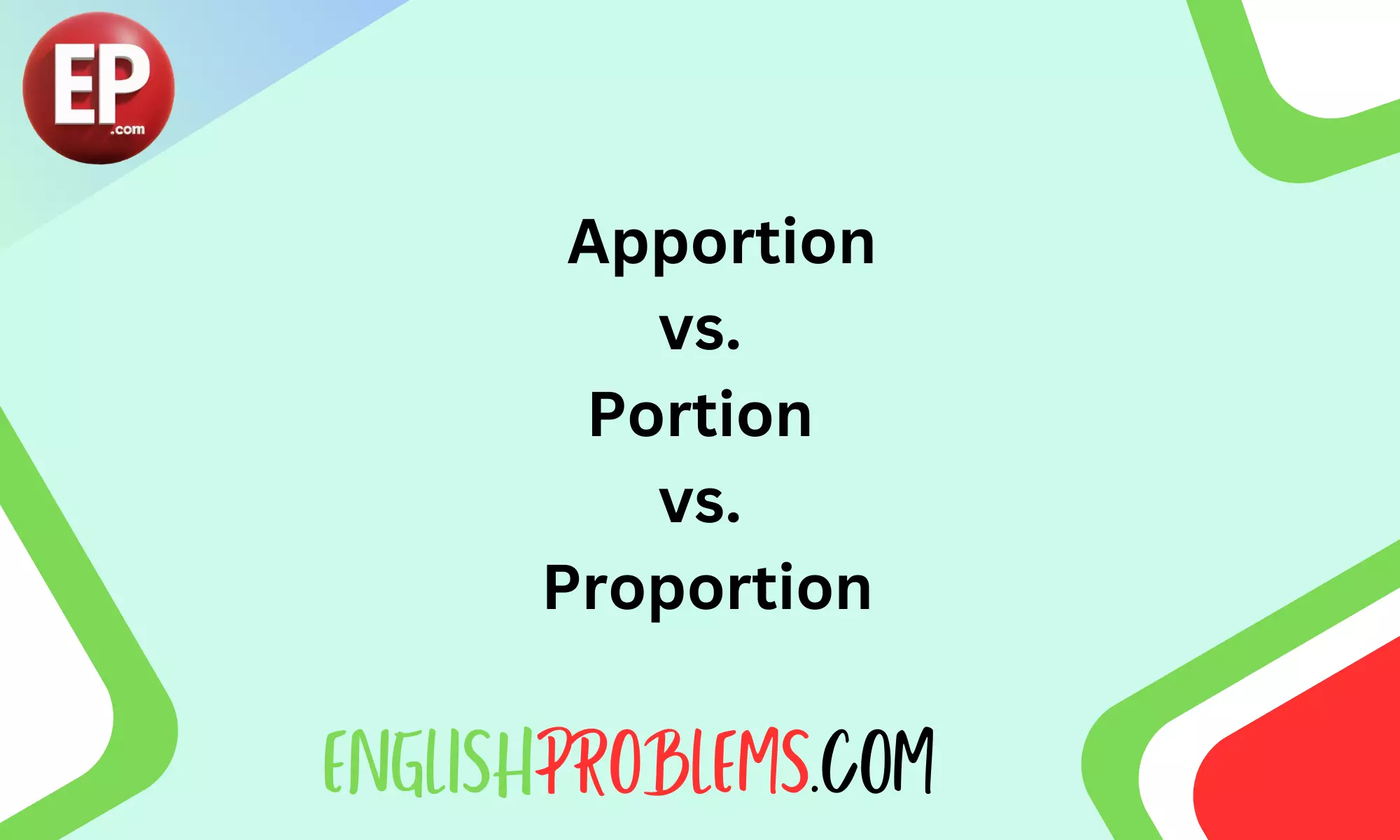Have you ever found yourself puzzled by the subtle differences between “apportion,” “portion,” and “proportion”? These words might seem interchangeable at first glance, but each has its own distinct meaning and usage. Understanding these differences can enhance your writing and communication skills, making you more precise and articulate.
In this comprehensive blog post, we will delve into the definitions, distinctions, and practical applications of these terms, ensuring you use them correctly and effectively.
Exploring the Definitions: Apportion, Portion, Proportion
Apportion
Definition: To divide and allocate something according to a plan or proportion.
Etymology: Originates from the Latin word “apportionare,” meaning “to divide.”
Example: “The budget was apportioned among the departments based on their needs.”
Portion
Definition: A part of a whole; an amount or section allocated to someone.
Etymology: Derived from the Latin word “portio,” meaning “share, part.”
Example: “He ate a portion of the cake.”
Proportion
Definition: A part, share, or number considered in comparative relation to a whole; the relationship of one thing to another in terms of size, quantity, or degree.
Etymology: From the Latin word “proportio,” meaning “comparative relation.”
Example: “The proportion of students to teachers in the school is 20:1.”
Comparing the Trio: A Practical Example
Let’s take a practical example to illustrate the differences between these terms. Imagine you’re dividing a pizza among friends.
- Apportion: You divide the pizza among friends based on how much each paid.
- Portion: The slice of pizza each person gets.
- Proportion: The relationship between the number of slices each person gets and the total number of slices.
This example highlights how each term fits into different contexts and uses.
Apportion: Dividing with Intent and Purpose
Definition and Etymology
Apportion comes from the Latin “apportionare,” which means “to divide.” It involves distributing something according to a plan, intent, or purpose.
Contextual Uses
Legal: “Apportioning responsibility among shareholders.”
Financial: “Apportioning funds based on departmental needs.”
Historical Examples: Allocation of resources in ancient civilizations, such as the division of land among Roman soldiers after a conquest.
When and How to Use ‘Apportion’ in Context
Guidelines for Use
- Use when dividing something among people or groups.
- Use when assigning responsibilities or resources.
Examples
- “The teacher apportioned the tasks among the students.”
- “The inheritance was apportioned equally among the siblings.”
The More You Know: Synonyms for ‘Apportion’
Synonyms
- Allocate
- Distribute
- Assign
- Divide
Usage in Sentences
- “Funds were allocated to various projects.”
- “Tasks were distributed among team members.”
The Meaning of ‘Portion’ and Its Everyday Use
Definition and Etymology
Portion, derived from the Latin “portio,” means a share or part of a whole. It refers to an amount or section allocated to someone.
Common Contexts
Food: “She served a portion of lasagna.”
Share of Something: “He donated a portion of his income to charity.”
Examples of ‘Portion’ in Various Contexts
Culinary
- “A portion of rice on the plate.”
Financial
- “A portion of the profits.”
Literary
- “A portion of the manuscript.”
Finding the Balance: Understanding ‘Proportion’
Definition and Etymology
Proportion comes from the Latin “proportio,” meaning “comparative relation.” It refers to the relationship of one thing to another in terms of size, quantity, or degree.
Contexts
Mathematics: “Proportions in equations.”
Art: “Proportions in human anatomy drawings.”
Daily Life: “Maintaining a healthy work-life proportion.”
Proportion as a Reflection of Harmony
Balance and Symmetry
Proportion is crucial in design and aesthetics, reflecting balance and symmetry.
Examples:
- Architecture: “The building’s proportions are aesthetically pleasing.”
- Cooking: “The right proportion of ingredients ensures a delicious dish.”
Proportion: Mathematical Ratio and Artistic Symmetry
Mathematical Uses
- Ratios: “The ratio of width to height in a rectangle.”
- Proportional Relationships: “Direct and inverse proportions.”
Artistic Uses
- Symmetry: “Proportional dimensions in sculptures.”
- Design: “Proportionate elements in graphic design.”
Utilizing ‘Apportion’, ‘Portion’, and ‘Proportion’ in Sentences
Practical Examples
- “The land was apportioned to the heirs.”
- “He received a portion of the winnings.”
- “The proportion of sugar to flour in the recipe is crucial.”
Tips for Proper Use
- Understand Context: Use ‘apportion’ for dividing, ‘portion’ for parts, and ‘proportion’ for relationships.
- Check for Clarity: Ensure the meaning is clear in your sentences.
Conclusion
In summary, understanding the differences between “apportion,” “portion,” and “proportion” is essential for precise communication. By mastering these terms, you can enhance your writing and convey your thoughts more clearly. Remember:
- Apportion is about dividing with intent.
- Portion is a part of a whole.
- Proportion is the relationship between parts.
Use these terms accurately to elevate your language and express your ideas effectively.
This comprehensive guide should provide you with a deep understanding of “apportion,” “portion,” and “proportion,” helping you to use them correctly in various contexts. By applying these concepts, you can communicate more precisely and effectively in both written and spoken language.

Dariel Campbell is a language aficionado dedicated to demystifying English problems for learners worldwide. His approachable writing style and thorough explanations turn confusion into clarity. With Dariel’s guidance, mastering the English language becomes a rewarding and empowering experience.










